The Radlab: People in Service to Society

 Enlarge
Enlarge
Faculty and students in the Radiation Laboratory study electromagnetics, which is the interaction of electric and magnetic fields. Electromagnetics is fundamental to the field of electrical and computer engineering, and spans all technologies within the electromagnetic spectrum. Practical applications range from early radar to seeing through walls, dc to wireless power and energy systems, remote sensing of the environment, medical imaging, communications, and even modern computer design.
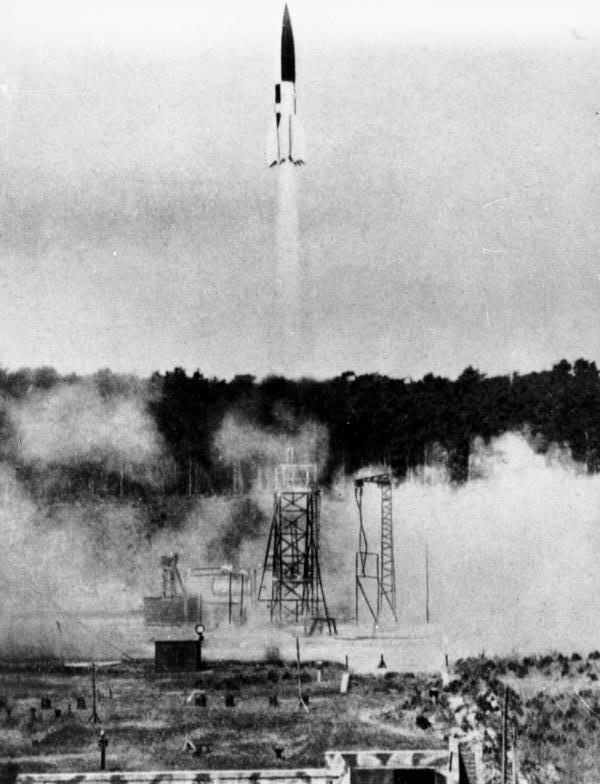
 Enlarge
Enlarge
Early History at Willow Run
In 1948, an Upper Atmospheric Physics Group was formed within Willow Run, later renamed the Theory and Analysis Department. Prof. Keeve M. (Kip) Siegel was named head of the group in 1949. One key activity of this group was to develop techniques for predicting the radar scattering cross section (RCS) of complicated targets. In this capacity, they contributed to the BOMARC and MIRO projects, which were concerned with the defense of the continental United States against armed and piloted aircraft.
The Michigan group became experts in this field, and shared their knowledge widely. They published a series of reports entitled “Studies in Radar Cross Sections,” beginning in 1953. These studies were used to predict the radar cross section of complicated targets using electromagnetic scattering.
In 1955, the group held an URSI-sponsored Symposium on Electromagnetic Wave Theory that was attended by most of the scientists involved in electromagnetic scattering around the world. The papers presented, published the following year in a special issue of the IRE Transactions on Antennas and Propagation, became standard references in the field.
A complete report of techniques for RCS calculations and interpretation of measured data was published in 1959 as “A Theoretical Method for the Calculation of the Radar Cross Sections of Aircraft and Missiles.” This report was the basis for the 1968 book, Methods of Radar Cross Section Analysis, edited by J. W. Crispin, Jr. and Siegel.
Newly-named RADLAB Joins EE, and gets a Chamber
In 1957, the Theory and Analysis Department became a laboratory of the Electrical Engineering Department and assumed its current name, Radiation Laboratory (Radlab). Siegel continued his role as lab director, and was appointed professor of Electrical Engineering later that year.
The offices for the researchers were moved out of Willow Run, while the experimental facilities remained. One of the key facilities needed to conduct actual experiments was called an anechoic chamber.
An anechoic chamber is a very large room coated with a material to reduce any reflection of signals off the wall. At the time, the material was not very good, so you needed a large room to help reduce the reflected signals.
There were only two anechoic chambers in existence by 1957. One was in Canada, and there was a small one at Ohio State University. To facilitate research at Michigan, the RADLAB built its own anechoic chamber in 1958.

 Enlarge
Enlarge
“We built a 100 ft. chamber on the 2nd floor of Hanger I,” recalled Prof. Senior. “For the next ten years the chamber was in almost continuous use for antenna and cross section measurements.”
RCS Research Spawns a Startup
Kip Siegel founded the company, Conductron Corporation in 1960 based on the lab’s newly-developed method for calculating cross sections. The goal of the company was to develop materials and ultimately missiles and nose cones that would have a reduced cross section, making them harder to detect.
Located in Ann Arbor, Conductron became one of the largest companies in the U.S. for a period of at least five years. It was later absorbed by McDonnell Douglas Corporation. Just a year after he founded Conductron, Siegel resigned from the Radlab as his activities at the company became a significant conflict of interest.

 Enlarge
Enlarge
After Siegel’s departure, Ralph E. Hiatt took over as director. Hired in 1958 after having been Chief of the Antenna Laboratory of the Air Force Cambridge Research Center, Hiatt’s research focused on radar antennas and radar cross section measurements.
Hiatt, along with Siegel and several other Radlab faculty, contributed to a “Special Issue on Radar Reflectivity” of the Proceedings of the IEEE, published in 1965. The issue was particularly useful, wrote Siegel, “in determining how far one can go today in making comparisons between the results of calculations, and of the experiments reported from the new laboratory facilities recently developed in the United States.”
Expanding Applications for RCS: Stealth Technology
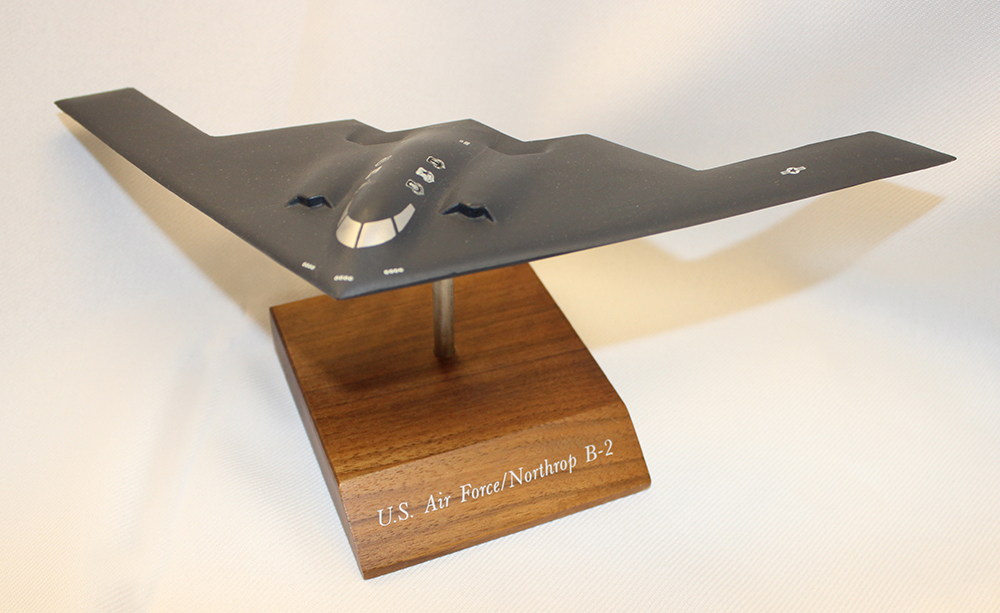
 Enlarge
Enlarge
Before he left to focus solely on Conductron, Prof. Siegel convinced Thomas B.A. Senior in 1957 to leave his position as Senior Scientific Officer at the Radar Research and Development Establishment in England and join the Radiation Laboratory. Senior’s expertise fit in perfectly with current lab activities.
One such activity was a U.S Air Force project to measure surface fields on missiles and aircraft called SURF. The SURF project enable the Radlab to build a new anechoic chamber right on campus. This new tapered chamber, the first of its kind, was developed with unique materials with very low reflectively, allowing it to be a much smaller size.
Using this new chamber, Senior created many of the analytical tools needed to predict how RCS reduction can be accomplished using shaping and radar-absorbing materials. Senior’s group led to some of the first designs for low radar cross section aircraft, which directly impacted the design of stealth aircraft in the U.S. Stealth technology is the use of design materials and fabrication to reduce the radar detectability of a target.
The aircraft were designed to be very thin, allowing for very little reflection. The cockpit and overall shape of the aircraft was curved for the same reason. The aircraft was also to be made of materials that would further reduce the cross section.
“The first model of the stealth aircraft was measured by us,” recalled Senior.
Wind Turbines and early TV reception
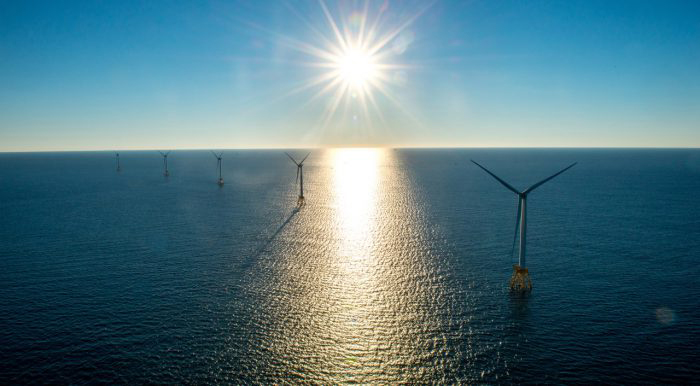
 Enlarge
Enlarge
During the 1970s, Senior and his group, which included lead researcher and research scientist Dr. Dipak Sengupta, were the first to recognize how large wind turbines can cause interference to electromagnetic systems, such as television.
In 1976, gas prices were soaring, making wind a viable option for energy. CBS Technology Laboratories funded research to understand how the turbines might be impacting television reception. Senior’s research proved that the wind turbines installed on Block Island were, in fact, negatively impacting television reception for residents of Rhode Island, leading to the U.S. government providing cable to every resident in the state. Back then, the turbines were made of metal which dramatically increased the interference. Senior and his team developed procedures that are now part of all environmental assessments of wind turbines.
The research was funded for seven years (until gas prices finally went down), and the Radlab remained the premier source of all electromagnetic data for the environmental impact assessments required of wind turbine installations.
Student Sit-ins
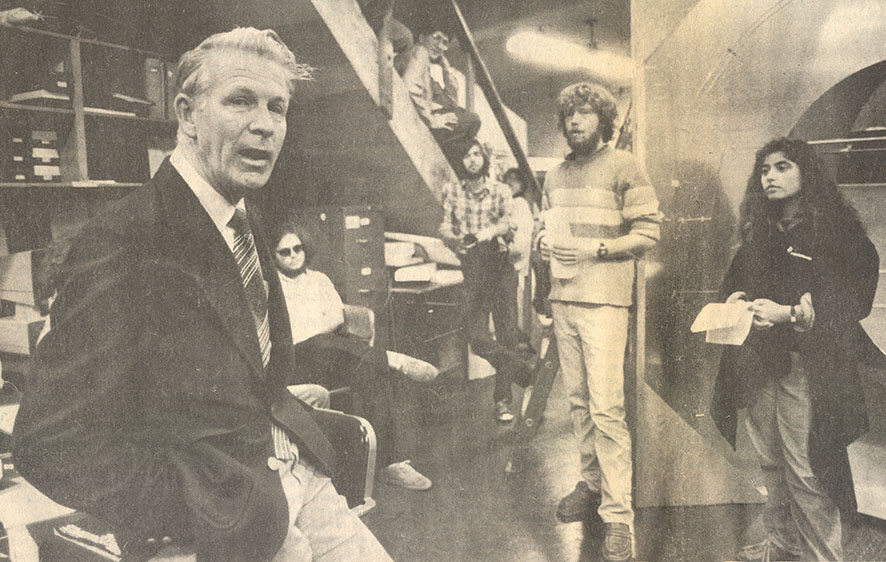
 Enlarge
Enlarge
Prof. Senior directed the RADLAB from 1975-1987. During this time, military research, especially classified, on campus was a target for student activists. In 1983, 26 students staged the first of several lab sit-ins in protest of the university’s involvement in military research. Called the Progressive Student Network, the members managed to slow operations in Senior’s group for several days.
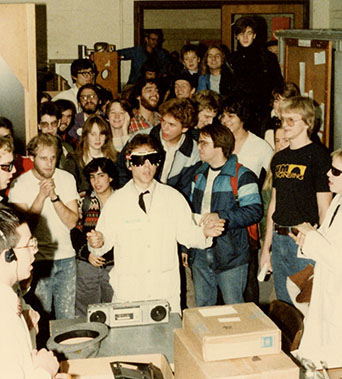
 Enlarge
Enlarge
A counter-protest group, naming themselves the Nuclear Saints of America, eventually converged on the lab as well, intent on resuming its research activities uninterrupted and “cleansing the lab from evil forces.”
They stated in their manifest, “At this moment, 15 members of the Nuclear Saints of America have entered the laboratory of the Prophet Professor Thomas B.A. Senior to do military research, and they will not leave until they get some done.”
These sit-ins ceased when the Radlab moved to North Campus with the rest of the Department in 1986.
With this move to the new EECS Building, the Radlab’s theoretical and experimental activities were located in the same building for the very first time. A 50 ft. tapered anechoic chamber, still in use, was part of the new facilities.
Leadership and Advances in Remote Sensing
Mapping Vegetation, Trees and Forests
By the 1980’s, the main areas of Radlab research included electromagnetic scattering from both manmade and natural targets, microwave and millimeter wave remote sensing of terrain and vegetation, and the computer-aided design (CAD) of microwave and millimeter wave circuits.
Michigan’s reputation in the area of remote sensing was cemented through the research and leadership of Prof. Fawwaz Ulaby, considered the Father of microwave remote sensing. Ulaby came to Michigan in 1984, having already established nationally recognized program in remote sensing while at the University of Kansas.
Trees and overall forest structure is an important indication of the earth’s carbon cycle, which impacts global climate, biodiversity, land use and development, and more. Trees absorb atmospheric CO2 through photosynthesis and then release it through decomposition. With 30% of the Earth’s landmass comprised of forests, scientists need a detailed understanding of their size and makeup to evaluate their overall impact.
In 1988, Ulaby developed the Michigan Microwave Canopy Scattering model (MIMICS). This technique for the remote sensing of biomass (in particular, tree canopies) has been widely used and cited by the research community.
Prof. Kamal Sarabandi worked on MIMICS as a graduate student under Ulaby. His dissertation on electromagnetic scattering from vegetation canopies demonstrated pioneering work in the use of imaging radar systems for monitoring vegetation at the global scale. Many of his algorithms and theoretical models are considered classics and are heavily used by remote sensing practitioners even today.
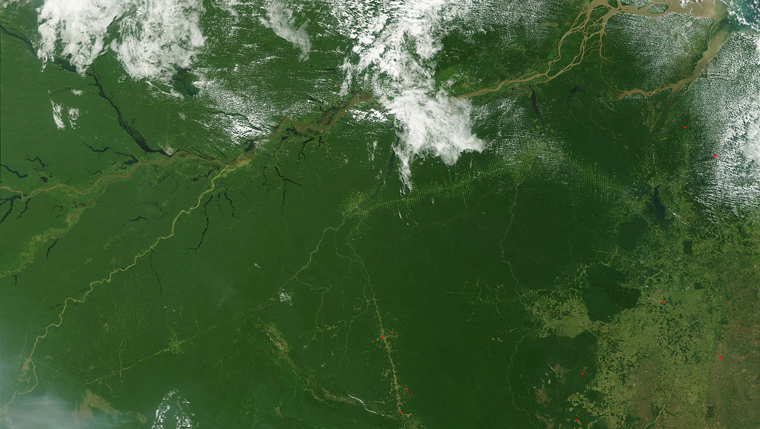
 Enlarge
Enlarge
By the late 1990’s, MIMICS was able to determine with increasing sensitivity biomass above and below ground, and continues to be used by researchers across the globe.
Today, there are several methods to determine forest structure, each with their own strengths and drawbacks. Scientists agree that satellites can provide the data most efficiently, but there are a variety of sensing modalities used to acquire forest structure, with none being best for all types of forests.
Sarabandi’s group of students and researchers are actively working to find a better way to quantify forest structure around the globe. They are developing a methodology that can be used to monitor the Earth’s various types of forests (deciduous, coniferous, and mixed) by creating models based on a collection of multi-modal remote sensing data, tracked over time.
Earth Mapping
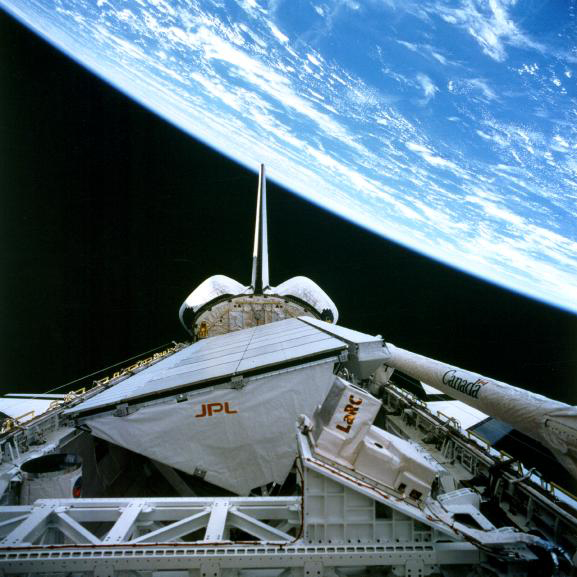
 Enlarge
Enlarge
In 1994, Fawwaz Ulaby, Kamal Sarabandi, and other members of their group were instrumental in the design and calibration of the Shuttle Imaging Radar that flew on NASA’s Shuttle Imaging Radar-C (SIR-C) mission in 1994. This was, and may still be, the most advanced radar system to ever fly in space. It mapped large portions of the Earth’s land surface, and resulted in the launch of later satellite missions by Canada, Japan, and the European Space Agency.
Prof. Sarabandi was later involved in the Shuttle Radar Topography Mission (SRTM), which provided data to generate the first nearly global, high-accuracy topographical map of the Earth. The shuttle was launched aboard the Space Shuttle Endeavour on Feb. 11, 2000. High-resolution topographic data generated from this mission continues to be used worldwide.
Soil Moisture and Climate
Snow and ice levels have serious ecological consequences. “California is in a drought not because of a lack of precipitation, but because of a lack of snow in the Sierras,” explains Prof. Sarabandi. “The same thing is happening in India. In the Himalayas – if it rains and doesn’t snow, the water just goes away.”
Understanding the phenomena at play in these regions can help to better manage resources. Being able to anticipate a drought, for example, would help mitigate water waste and preserve reservoirs.
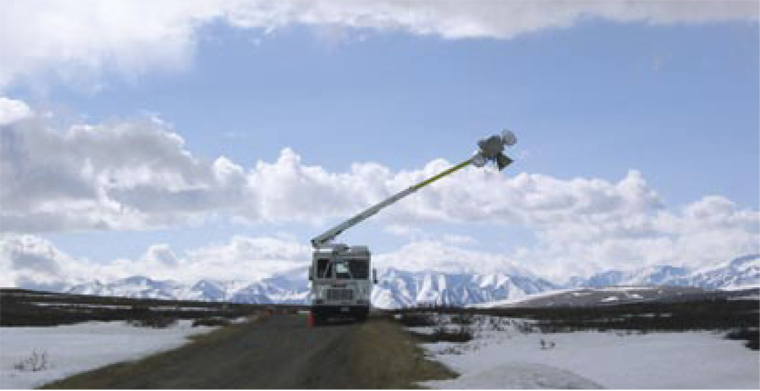
 Enlarge
Enlarge
As early as the 1970’s, Prof. Tony England, who was part of the U.S Geological Survey, was among the first scientists who realized that you couldn’t understand global climate and the human effect on climate without considering the interrelationship of the atmosphere, the ocean, and the water cycle. England saw that hydrologists did not look at the water cycle in a global perspective, and he realized it was because they lacked the tools to do so.
England’s team was the first to incorporate microwave brightness to determine levels of moisture in the soil. He built instruments to calibrate and validate information received from Space not only for Michigan, but other institutions. His group was one of the first to generate land-surface models that were linked to satellite observations.
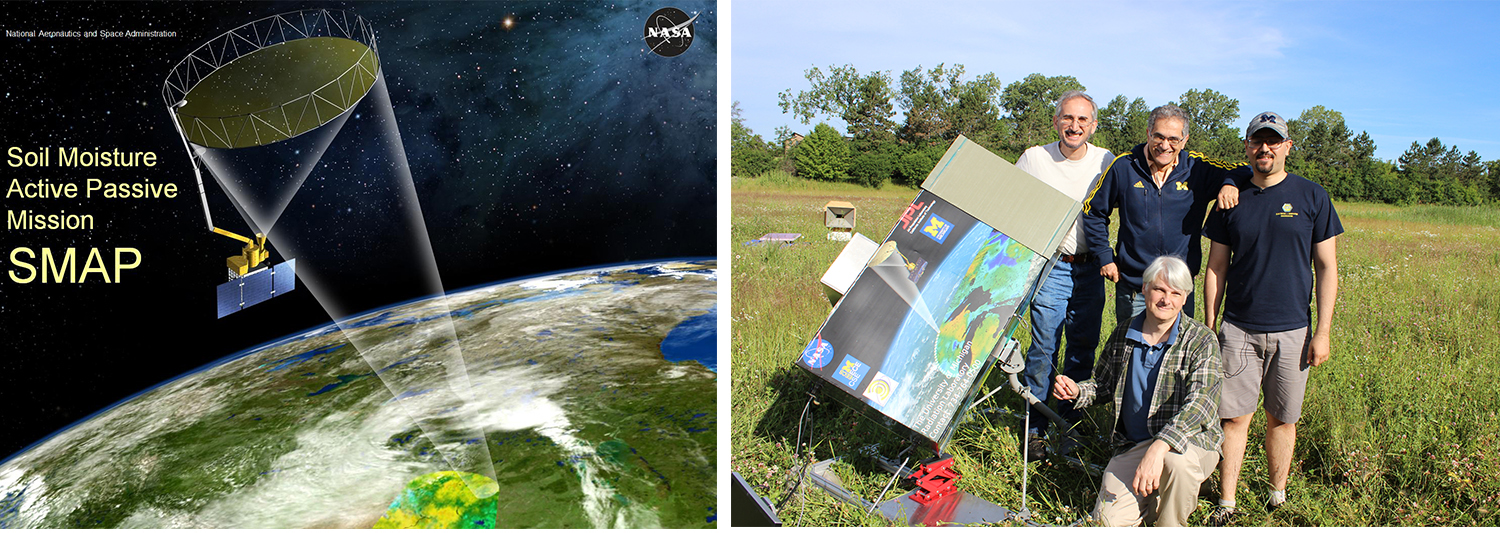
 Enlarge
Enlarge
Prof. Kamal Sarabandi and his team constructed the most powerful radar calibration device in the world to interface with NASA’s newest orbiting satellite, called Soil Moisture Active Passive (SMAP), which launched Jan. 31, 2015. SMAP is a 5-year mission that is measuring the amount of water present in the top 2 inches of soil around the entire Earth (excluding the Poles). The data collected by SMAP is expected to improve our ability to forecast the weather, monitor droughts, predict floods, enhance crop productivity, and understand the Earth’s water, energy, and carbon cycles. SMAP is the first satellite ever built to specifically target soil moisture.
Through a new NASA-funded project initiated in 2015, Sarabandi is exploring the fundamental capabilities of remote sensing. This program aims to create theoretical models for remote sensing of ice and snow. Specifically, the research seeks to develop a better understanding of wave propagation and scattering, and to improve tools for future monitoring. This work could feed into the development of new sensors for a variety of remote sensing applications. Eventually, after enough data is gathered, techniques for reversing these problems as they unfold may be possible.
The NASA Connection
With much of their research taking place in Space, the Radlab faculty have extensive ties to NASA and its missions. Before joining Michigan in 1988, England was an actual NASA astronaut who flew during the Space Shuttle program.
In addition, Radlab faculty have been recognized for their leadership and service to NASA. Ulaby received a NASA Group Achievement Award for the Shuttle Imaging Radar Science Team, as well as the NASA/Dept of the Interior Pecora Award for outstanding contributions to remote sensing. Sarabandi has served as a member of the NASA Advisory Council, and received a NASA Certificate of Appreciation for Significant Contribution to the Workshop on Science Associated with the Lunar Exploration Architecture.
The research of Prof. Brian Gilchrist is focused on Space Electrodynamics and Tether Systems. He was director of the Shuttle Electrodynamic Tether System (SETS) experiment that flew on the STS-75 shuttle mission in 1996. He is Director of the Space Physics Research Laboratory, and is currently working on a cube-sat project with students that is intended to be part of a future NASA mission.
Terahertz Technology
The NASA Center for Space Terahertz Technology, established in 1988, was the first of its kind in the country. Directed by Fawwaz Ulaby, this 10-year, $13M Center pioneered the development of Terahertz antenna arrays, sources, and circuit components.
The Center’s technical direction and scientific objectives were defined to match NASA’s objectives in advancing its astrophysics and Earth Observing Systems (EOS).
The Center helped create international forums for research in THz technology. These included the publication of special issues of scientific journals dedicated to this subject, and the establishment of the Symposium on Space Terahertz (SSTT), which was first convened in Ann Arbor in 1990.
Before 2000, devices to generate, control, and detect THz signals were non-existent. Today, THz technology is used in many medical, military, and industrial applications, and research continues in this fertile area.
The Center for Objective Microelectronics and Biomimetic Advanced Technology (COMBAT)
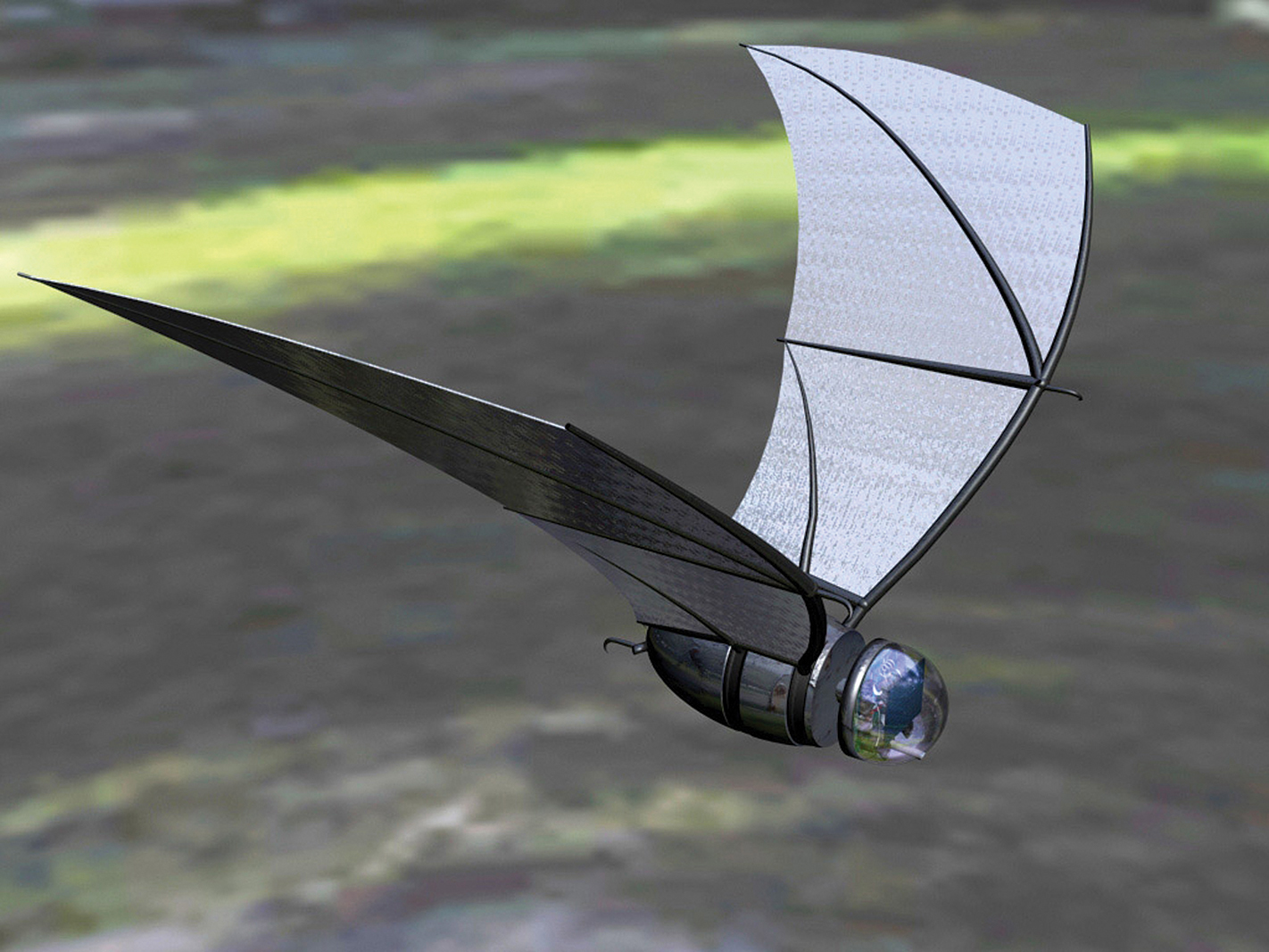
 Enlarge
Enlarge
The 10-year Center for Objective Microelectronics and Biomimetic Advanced Technology (COMBAT) was established at Michigan in 2008. Directed by Sarabandi, COMBAT focused on remote sensing, autonomy, communications, and operation in an ensemble of collaborating mobile micro-scale robotic platforms.
COMBAT researchers developed a system that included: evaporation as a power source; flexible, highly-efficient photovoltaic cells; low-power network connectivity; miniature low-profile antennas; a navigation system; embedded sensors for detection of airborne chemicals, nuclear radiation; infrared imaging; and low-power data processing.
COMBAT is one of four centers that the U.S. Army Research Laboratory launched under the Micro Autonomous Systems and Technology (MAST) Collaborative Technology Alliance to work toward a vision of small, ground (crawlers and rovers) and air (flapping, rotary, and fixed wings) robotic platforms that could sense and communicate.
This entire activity has enabled broad collaborative efforts among industry, academia, and the Army Research Laboratory. COMBAT includes UC-Berkeley and the University of New Mexico as research partners.
Antennas
Radios were among the core early technologies that kept electrical engineers busy in the early decades of the 20th century. Even today, all radios need antennas to convert electric power into radio waves to transmit and receive information.
Radio waves are electromagnetic waves, and the antenna couples the electrical connection of transmitters and receivers to the electromagnetic field. The first antenna was built by Heinrich Hertz in 1888, just a year before the first course in electrical engineering was taught at Michigan. Hertz did this reportedly to prove James Maxwell’s theory.
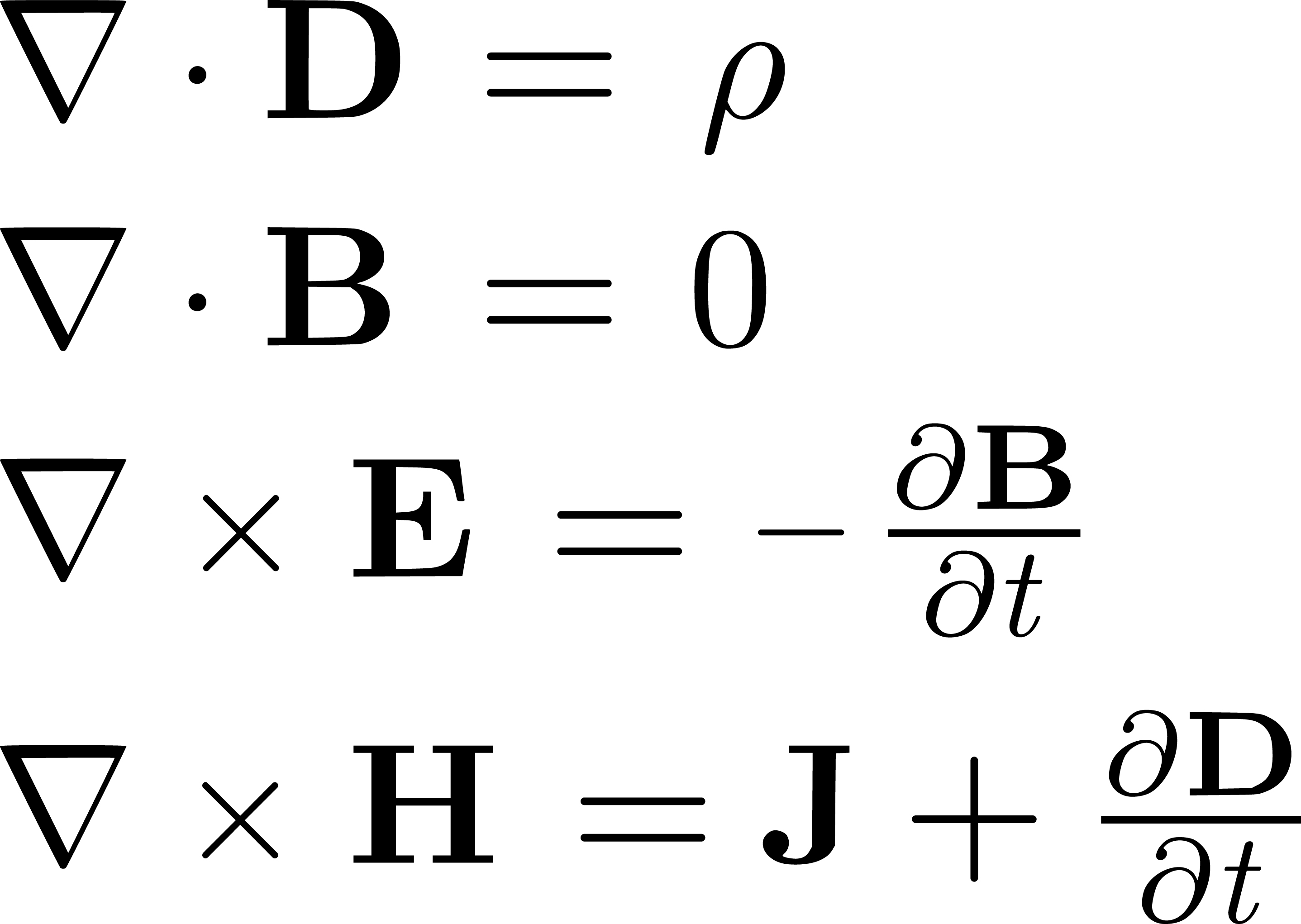
 Enlarge
Enlarge
With the rise of electronics and computers in the middle of the 20th century, followed by the extreme shrinking of electronics and the move to wireless in the 21th century, research into building “the better antenna” has continued unabated.
Prof. Chen-To Tai, who joined the department in 1964, was an acknowledged leader in this area. He was elected to the National Academy of Engineering for “For basic contributions to the advancement of electromagnetic theory and its application to antenna design,” in 1987. He also received the IEEE Heinrich Hertz Medal in 1998.
Among Tai’s contributions were establishing the foundation of multielement array antennas, which are used extensively in a variety of radio systems. A year before he retired in 1986, Prof. Tai was honored by his colleagues and former Ph.D. students in a special session at the 1985 IEEE International Symposium on Antennas and Propagation and North American Radio Science Meeting.
Terahertz antenna arrays, sources, and circuit components were pioneered in the late 1980’s and throughout the 1990’s within the Center for Space Terahertz Technology.

 Enlarge
Enlarge
In 2000, an electromagnetic metamaterials program, the first of its kind, was established under the direction of Prof. Sarabandi in collaboration with the Materials Science Department under a MURI DARPA program. Metamaterials refer to man-made materials that exhibit properties not observed in nature. Through this five-year program, novel magneto-dielectric, circuit-embedded, electromagnetic band-gap, reactive impedance surfaces and metasurfaces for antenna miniaturization were demonstrated for the first time.
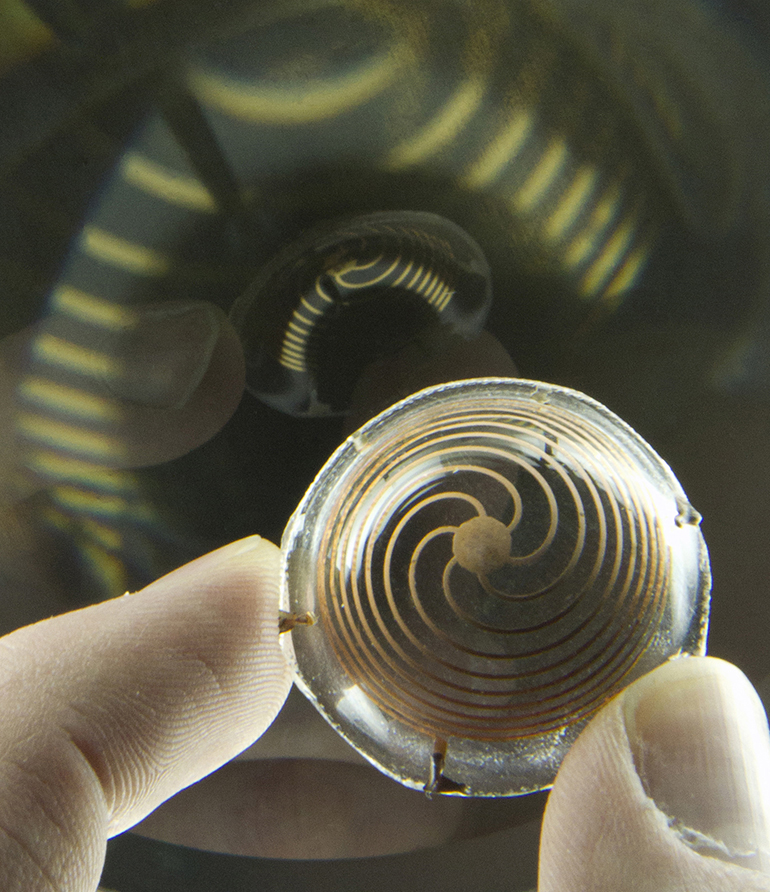
 Enlarge
Enlarge
Unique research in the application of metamaterials to electromagnetic devices is being carried out by Prof. Anthony Grbic, who received a Presidential Early Career Award for Scientists and Engineers (PECASE) in 2009 for his work in this area, three years after joining the department.
Prof. Grbic’s research with Prof. Robert Merlin in the department of Physics in the area of near-field superlenses using near-field plates (NFP) is of great interest to the scientific community. NFP’s hold promise for a number of areas including high resolution probing devices, quasi-optical and optical components, devices for wireless non-radiative power transfer, as well as antennas and nano-antennas.
In other research with Merlin, Grbic focused microwaves to specks 20 times smaller than their wavelength and five times smaller than other devices have achieved. This development could allow advances such as laptop computers that recharge without plugging in, and higher-resolution microscopes for observing molecules.
Antenna research is also leading to improved methods to see through walls. Through-the-wall imaging is a popular field that enables better threat assessment in rescue and law enforcement settings. Sarabandi is leading research in this area to improve on the speed, portability, and accuracy of many commercial models.
Wireless Power Transfer
First demonstrated by Nikola Tesla in the 1880s, wireless power transfer has only recently been developed to the point where it is being used in consumer electronics. The prevalence of wireless devices such as smart phones and laptops fueled interest in this area of research. Potential applications also include wireless powering of implanted medical devices and ubiquitous charging of electric vehicles.
Radlab faculty and students are actively pursuing wireless power transfer from both fundamental and practical perspectives. A major initiative is focused on powering devices from the size of a cell phone to an electric vehicle with greater ease and/or efficiency than possible today.
Prof. Amir Mortazawi created a device that allows for a greater distance between the device and the power than is currently possible. He envisions a future in which an electric vehicle may even be able to charge while at a stoplight, or even driving down the road.
Computational Electromagnetics (CEM)
Computational electromagnetics (CEM) involves modeling how the electromagnetic field interacts with physical objects and the environment. It is important to the design and modeling of antenna, radar, satellite and other communication systems, optical, nanophotonic and electronic devices, medical imaging, and other applications and devices. The field has grown in response to the computational power available to engineers for modelling through computer simulation.
Eric Michielssen, Louise Ganiard Johnson Professor of Engineering and Associate Vice President for Advanced Research Computing, is an acknowledged leader in the field. Through his fundamental contributions, researchers have been able to tackle very large and multi-scale computational problems not feasible previously.
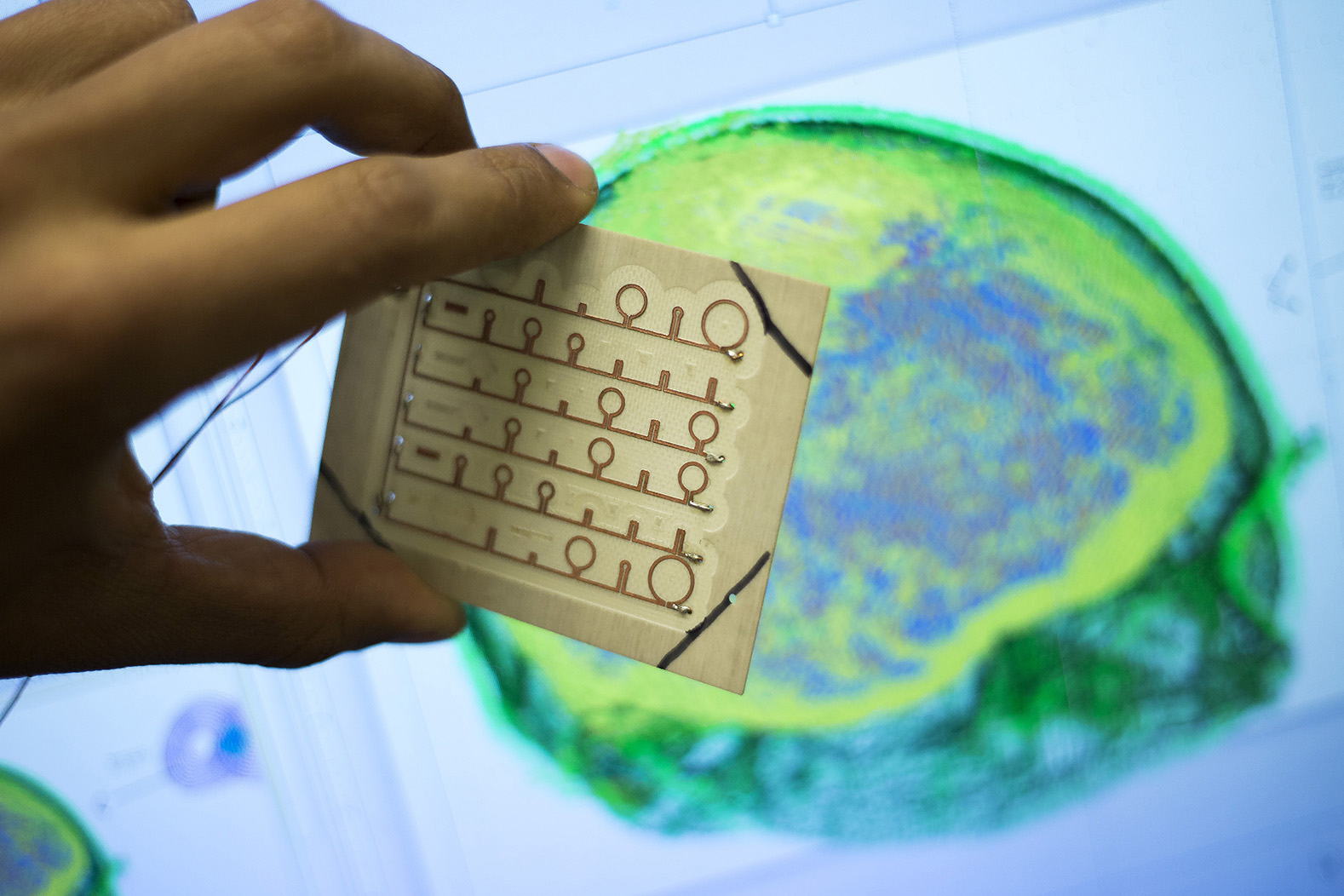
 Enlarge
Enlarge
In recent work, he applied his techniques to a research project initiated by Prof. Luis Hernandez-Garcia in Biomedical Engineering related to transcranial magnetic stimulation, a brain stimulation technique that is used to treat tough cases of depression. Prof. Grbic contributed to the design of the device, which is expected to open up a lot of opportunities to treat depression and other mental illness, as well as probing the brain for better understanding of its secrets.
Plasma Science and Engineering
Mark Kushner, George I. Haddad Professor of Electrical Engineering and Computer Science, was recruited to Michigan in 2008 to both bring together and broaden the ongoing activities at Michigan in the area of plasma science. He immediately established the Michigan Institute for Plasma Science and Engineering (MIPSE), which is a community of faculty, staff and students at U-M and Michigan State University whose research and education programs are devoted to the advancement of the science and technology of plasmas. The research spans laser-produced plasmas for particle acceleration to plasmas in the earth’s magnetosphere, with specialties in low temperature plasmas (LTP) and high energy density plasmas (HEDP).
In 2009, Kushner founded the Center for Predictive Control of Plasma Kinetics: Multi-phase and Bounded Systems, funded by the U.S. Department of Energy Office of Fusion Energy Sciences. The Center enables fundamental research on low-temperature plasmas, which are ionized gases with broad potential for practical technological advancements.
A vast array of modern technologies, including renewable energy sources, lighting, microelectronics, and medicine, would not exist in the absence of low-temperature plasmas. The fundamental research that is being conducted at the Center could lead to more efficient solar cells, finer-featured microchips, and new medical tools that cut and heal tissues with plasma-activated chemistry.
The Center is a unique collaboration between nine universities and two national laboratories. Michigan researchers come from units across the university, including physics, engineering, space science and mathematics.
Shooting Stars
A few notable faculty made their mark at Michigan before moving on to other opportunities. Included among these individuals are Linda Katehi and John Volakis, who arrived at Michigan in 1984, and Gabriel Rebeiz, who was hired in 1988. Katehi established a research program in microstrip devices and later moved into administration both at Michigan and elsewhere (including dean of engineering at Purdue University, provost at the University of Illinois Urbana-Champaign, and chancellor of the University of California). Volakis, who served as Radlab Director between 1988-2000, established a world-wide reputation in scattering before returning to his alma mater, Ohio State University, where he is the Chope Chair Professor of Electrical and Computer Engineering. Finally, while at Michigan, Rebeiz published the book, RF MEMS: Theory, Design and Technology, considered one of the first of its kind and a standard in the field. He is currently a professor at the University of California, San Diego, and a member of the National Academy of Engineering.
The Future
The Radlab today continues its tradition of excellence combining fundamental science with highly practical applications. The field of electromagnetics, which at its core seeks to understand and exploit how electromagnetic fields interact with the environment, is highly mathematical, requiring much of its practitioners. The invisible electromagnetic spectrum holds secrets that have yielded great advances for the betterment of modern society, and promises continued benefits in the areas of health, transportation, environment, agriculture, space exploration, and much more.
 MENU
MENU 
